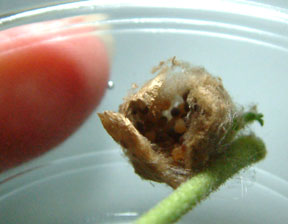I’ve seen amazing transformations in small areas of my yard by removing introduced exotic plants and restoring native plants to the landscape. Native Plants. The Mexican mountain marigold (pictured) provides food for pollen-eating insects even in the winter. I keep trying small gestures to provide more opportunities for native species. Bee Box.
Just in the last two months we’ve seen an amazing biodiversity in spider species without really trying: red jumping spider, trapdoor spider, green lynx spider. In the past I’ve found small areas around the house are home to numerous spider species. Here Be Spiders.
This afternoon I checked on the green lynx spider egg casing. It has survived the December rains, but for the past week the mother protecting the egg sac has been gone. Did she perish in the cold weather? Temperatures have been in the mid-30s to 40s at night. This spider species only lives about a year and adults typically do not survive winter weather.
According to several university websites, females lay their eggs in an egg sac in autumn. We saw this egg sac in the second week of November. The female guards the eggs for 2 weeks until they hatch. The mother opens the tough webbing of the egg sac to release the spiderlings and she provides protection and sometimes food for the next 2-3 weeks. See University of CA, Irvine photos. When the young spiders disperse, her job is done. The youngsters will overwinter, but their mother will die.
Last year we had an unusually warm December and early January. We discovered our first green lynx spider in the yard with her egg sac on the scented geraniums in the vegetable garden. By February, drenching winter rains destroyed the egg sac.
 This year it has been almost 2 months since I first discovered the green lynx spider and her egg sac, but again the spiderlings have not hatched. I don’t know if the female realized the eggs were not going to hatch and abandoned them or if she died. Typically, a female will guard her egg sacs until she perishes from starvation. Last week the female was looking very thin.
This year it has been almost 2 months since I first discovered the green lynx spider and her egg sac, but again the spiderlings have not hatched. I don’t know if the female realized the eggs were not going to hatch and abandoned them or if she died. Typically, a female will guard her egg sacs until she perishes from starvation. Last week the female was looking very thin. What happened to these eggs? I decided to open up the egg sac and see whether or not the eggs were viable. Looking through my microscope I could see that about a third of the eggs seemed infertile, they were dark and showed no development. Another third or more appeared plump and ranging from an orangy-yellow to pale white. A few appeared to have been forming into spiderlings, the shape of the carapace was somewhat apparent. But these embryos on their way to becoming spiderlings, seemed slightly dried-up.
Considering we had nearly a week of rain in mid-December, this seems odd. But something with the weather was not right for these eggs to develop. For a second year in a row beautiful green lynx spiders have failed to reproduce in the garden.
Are there more green lynx spiders in the yard and I’ve just missed them? Are their other spiders failing to reproduce? This leads me back to the Backyard Biodiversity Project.
Are there creatures to waiting to be discovered right here in a backyard in Los Angeles, California? I think so. I plan to take a scientific look at the creatures and plants living in our small yard in one of the largest cities in the world. I’ve started the Backyard Biodiversity Project before only to be interrupted by acceptance to graduate school. Now I’m plunging into the year with the intention of spending the next 12 months on this project.
What’s in your backyard?



No comments:
Post a Comment